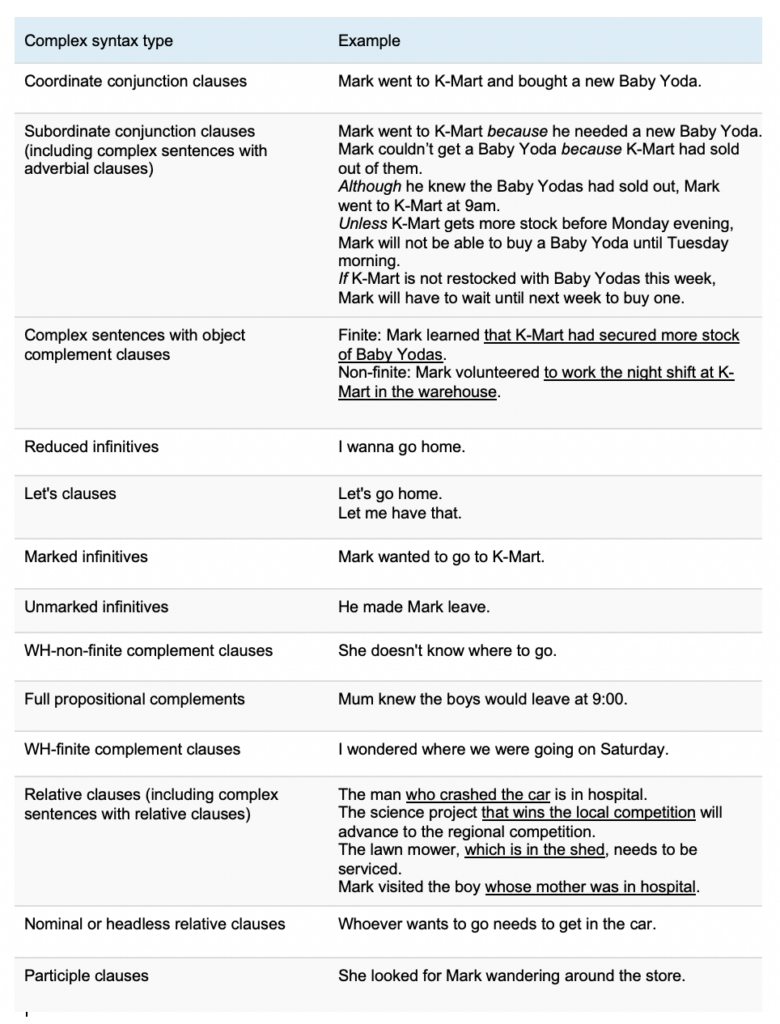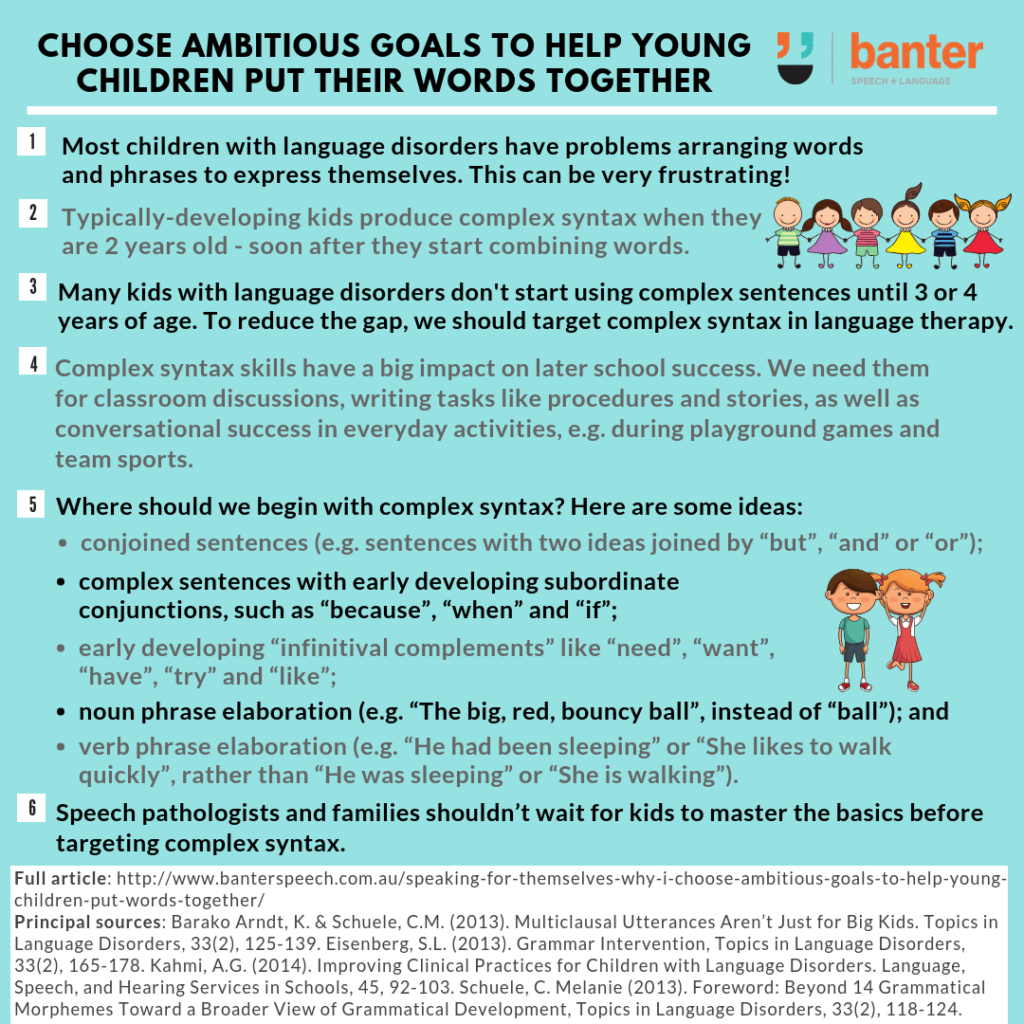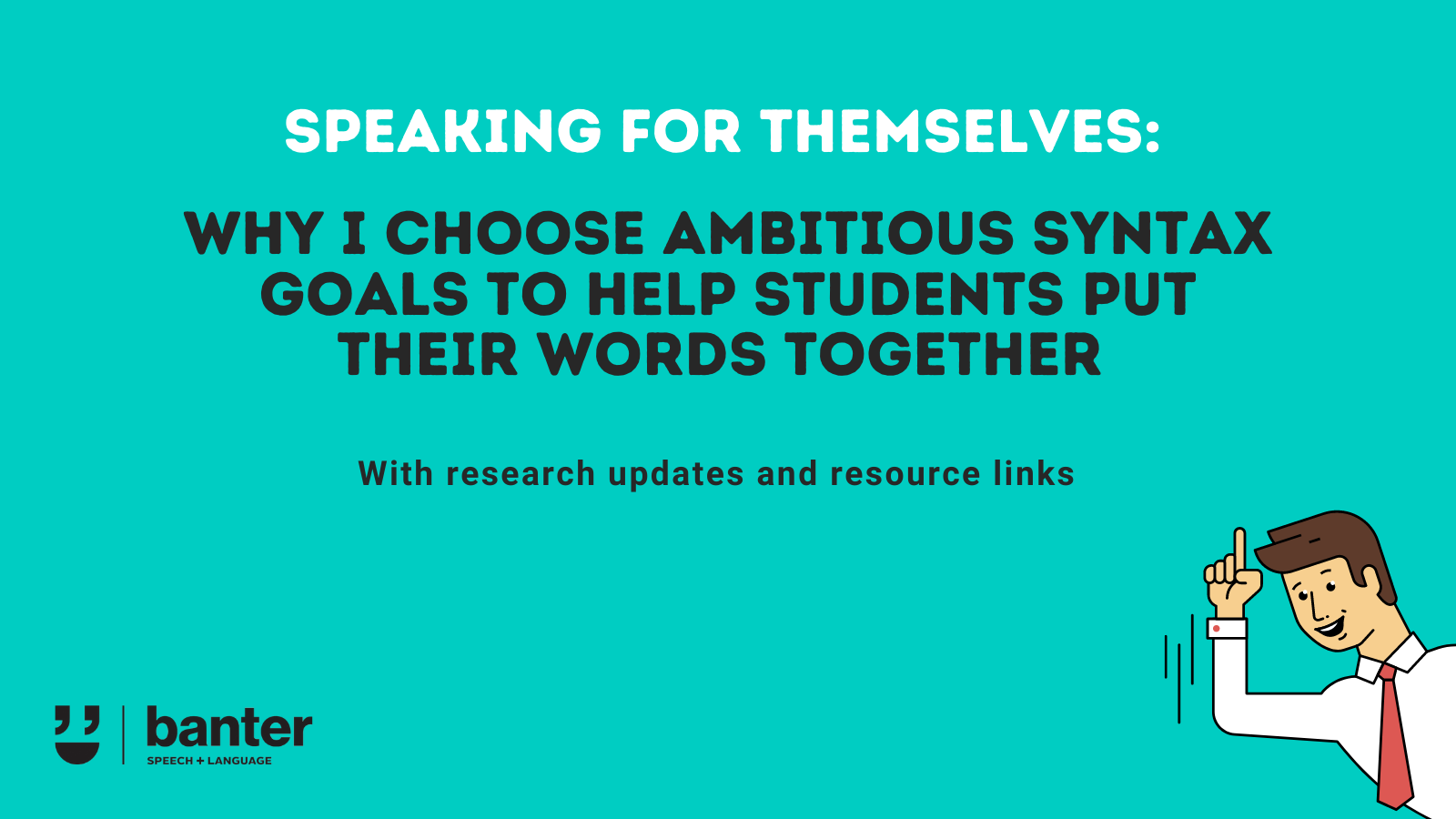Many, if not most, children with Developmental Language Disorder (DLD) and other language disorders have problems arranging words and phrases to express themselves clearly. This can be very frustrating for children themselves, as well as their families, teachers and peers.
To help students to express their ideas – and to reduce the gap between the skills of students with DLD and their typically developing peers – we must target the right goals. A growing body of research tells us to look beyond “early morphemes” and other developmental grammatical goals and focus on more complex goals – goals that improve multiple areas of areas of language and lead to functional gains in oral and written communication skills.
1. Common grammatical difficulties for children with language disorders
Common grammatical difficulties (also known as ‘syntactical difficulties’) for children with language disorders include problems:
- getting words into the right order (e.g. ‘Me ball kick’);
- with pronouns (e.g. with words like ‘I’, ‘you’, ‘he’, ‘she’, ‘him’, ‘her’, ‘they’, ‘us’, ‘mine’ and ‘your’);
- with plurals (e.g. ‘Mouses have pink footses’);
- with verbs (tense and agreement) and adverbs (e.g. ‘She catch the ball’ or ‘The boy he smashing the Lego yesterday’);
- leaving out unstressed ‘function’ words like ‘the’, ‘a’ and ‘to’ (‘Want Batman’);
- forming questions correctly (e.g. ‘does’ and ‘wh’ questions);
- forming sentences with negatives in them like ‘no’, ‘not’ or ‘don’t’;
- describing people, things or ideas, or actions in detail (e.g. saying ‘The man’, rather than ‘The thin man with the hammer’ or ‘She walked’, rather than ‘She had gone for a quick walk’); and
- using complex sentences (e.g. sentences containing words like ‘because’, ‘although’, ‘if’ and ‘when’) and syntax.
(Eisenberg, 2013).
2. Traditional speech pathology grammar goals are not ambitious enough
For many speech pathologists – partly because of our training and text books – grammar goals for young children start and end with what are known as ‘Brown’s 14 morphemes‘*.
Back in the 1960s, clinical psychologist Roger Brown studied the grammatical development of three typically developing children. From these studies, he identified 14 grammatical morphemes, which he found could be measured reliably:
- Present progressive -ing
- Prepositions in
- Preposition on
- Regular plural -s
- Irregular past tense
- Regular possessive -s
- Uncontractible copula ‘be’
- Articles (a, the, an)
- Regular past tense -ed
- Regular third person -s
- Irregular third person (does, has, says)
- Uncontractible auxiliary ‘be’
- Contractible copula ‘be’
- Contractible auxiliary ‘be’
(Brown, 1973).
Brown’s work was groundbreaking. But he never argued that his 14 morphemes were the most important targets for children to master. Nor did he argue that they presented special difficulty to children with language disorders. Unfortunately, many speech pathologists and others to this day:
- base their management plans for children with grammar problems on Brown’s 14 morphemes and don’t go further until the children are at school; and
- think that there is no point targeting more complex grammatical goals until the child has mastered Brown’s ‘basics’,
(Kamhi, 2014).
3. Research tells us we should target more complex language goals, earlier
We now know that:
- children don’t figure out simple sentences before moving to complex ones: once simple sentences emerge (e.g. 3-word utterances), children simultaneously figure out the details of simple sentences and complex syntax;
- typically developing children begin to produce complex syntax when they are 2 years old, soon after they start combining words;
- by 3 years of age, typical learners produce conjoined sentences and three kinds of complex sentences;
- children with language disorders:
- don’t tend to have difficulty learning some of Brown’s 14 morphemes, including ‘-ing’, plural /s/ and the prepositions ‘in’ and ‘on’;
- have significant difficulties learning grammatical morphemes that reflect tense and agreement (e.g. third person singular /s/, past tense /-ed/, the use of ‘do’, ‘does’ and ‘did’, and different forms of the verb ‘to be’ (e.g. is, are, am, was and were);
- compared with typically developing children, children with language disorders:
- often only start to use complex syntax between the ages of 3-4 years;
- are limited in their ability to combine verbs and complex sentence types; and
- are more likely to omit words (e.g. ‘to’ in infinitives, and ‘who/that’ in complex sentences), through at least until the age of 8 years;
- children with developmental language disorders produce fewer object complement complex sentences and use fewer cognitive verbs (e.g. ‘promise’, ‘decide’) in narratives and explanations (Owen Van Horne & Lin, 2011);
- school-aged children with developmental language disorders use half the number of adverbial and relative clauses in conversation (Marinellie, 2004);
- 8-year-old children with developmental language disorders used significantly fewer relative clauses in narratives than typically developing children of the same age (Zwisterlook et al., 2015);
- older children with developmental language disorders show lower frequencies of sentences with three or more clauses, sentences with more than one level of subordination depth, and sentences with relative clauses than their typically developing peers (Scott & Lane, 2008); and
- children with developmental language disorders make more errors in complex sentences compared to simple sentences (e.g. Owen, 2010) and make more errors with relative clauses compared to their age-matched peers (eg. Frizelle & Fletcher, 2014).
Complex sentences “up the language processing ante” for children (Balthazar & Scott, 2018).
This means speech pathologists:
- should focus on complex syntax in the pre-school years; and
- should not wait for children to master Brown’s 14 morphemes or basic clause structure before targeting complex syntax.
Barako Arndt & Schuele (2013).
4. Why should we target complex syntax early?
In addition to trying to narrow the gap between language typical and delayed children, Barako Arndt and Schuele (2013) identify a couple of important reasons for working on complex syntax with pre-schoolers:
- Complex syntax skills have a large impact on later academic success (Scott & Windsor, 2000). We need complex grammar for oral and written expression, as well as conversational success in everyday activities, e.g. during playground games and sport.
- From Kindergarten, children are expected to engage in classroom discussions, to answer higher-level questions, to summarise and explain complicated material, and to write using a variety of ‘genres’ (e.g. stories, procedures, opinions/arguments) that need sophisticated language structures and vocabulary, including complex syntax.
5. So, what exactly do we mean by complex syntax?
This section is a bit technical, so feel free to skip it if you are suffering flashbacks to high school grammar!
Complex syntax doesn’t just mean complex sentences. Barako Arndt & Schuele (2013) identify 13 kinds of complex grammar we should think about when setting goals for children:

Adapted from Barako Arndt & Schuele (2013) and Balthazar & Scott (2018).
In typically developing children, examples of all of these kinds of complex syntax are found in the speech of typically developing 4-5 year olds.
6. Where should we begin with complex syntax?
We need more research on this. Some suggestions based on the research cited below include targeting:
-
- compound sentences, e.g. sentences with two ideas joined by coordinating conjunctions like ‘for’, ‘and’, ‘nor’, ‘but’, ‘or’, ‘yet’ or ‘so’ – the so-called FANBOYS.
- complex sentences, with early developing subordinate conjunctions, such as ‘because’, ‘if’, ‘while’, and ‘when’;
- early developing simple infinitives sentences with infinitival complements like ‘need’, ‘want’, ‘have’, ‘try’ and ‘like’;
- scaffolded noun phrase elaboration using semantic features (e.g. ‘The big, yellow and red striped, beach ball’, instead of ‘ball’); and
- verb phrase elaboration (e.g. ‘He had been sleeping’ or ‘She likes to walk quickly’, rather than ‘He was sleeping’ or ‘She is walking’).
More recent research has looked at the benefits of targeting three types of complex sentences – sentences containing adverbial, object complement, and relative clauses (Balthazar & Scott, 2018). Clinically, with school-aged children, we’ve found it helpful to target later developing complex syntax targets like relative clauses featuring words like ‘who’, ‘which’, and ‘that’, because of:
-
- research showing how hard these clauses are to acquire for many children with language disorders, given their late development, lower frequency, and susceptibility to errors (e.g. Scott & Lane, 2008; Balthazar & Scott, 2018);
- how often relative clauses pop up in curriculum texts; and
- the usefulness of relative clauses in helping students to express their thoughts, feelings and ideas more precisely.
7. Effective language therapy for complex syntax: practical suggestions to help students to learn complex syntax
We’ve summarised several key elements of effective language therapy here. Useful elements include exposure and repetition, identification and scaffolded manipulation techniques, narrative or contextualised language intervention, (e.g. Balthazar & Scott, 2018; Peterson et al., 2008, and Tarvainen et al., 2021) and modification of the environment, including helping teachers to modify their language (Starling et al., 2012).
For older children and teenagers, we are guided by Dr Ukrainetz’s helpful RISE acronym: repeated opportunities, intense practice, systematic scaffolding and explicit instruction. Explicit intervention techniques – like teaching grammar rules – may be more effective and appropriate than implicit techniques alone, e.g. like modelling, modelling with auditory bombardment, focused stimulation, and recasting (e.g. Ebbels, 2014; Tarvainen et al., 2021).
In our clinical experience, learning by doing with scaffolding and lots of repetition often helps, too. Treatment effects can be increased by using a variety of target stimuli (e.g. Plante et al., 2014, which we look at here), and by adding metalinguistic activities (e.g. activities that make students think explicitly about the language goals).
Other evidence-informed ideas for targeting complex syntax therapy include:
- introducing each session by defining the target structure clearly;
- combining oral and written language intervention for school-age children, with sentence scaffolds, to reduce the load on working memory, recognising that some students may also have reading difficulties, such as dyslexia;
- including at least 30 repetitions of the target structure in each session (recognising that more does not always mean better);
- in addition to scaffolding, illustrating structural features with colour, shape blocks, arrows and animations (e.g. the Shape Coding intervention by Dr Susan Ebbels);
- using sentences:
- reflecting everyday experiences;
- from well known fables and narratives;
- found in informative texts about the physical and natural world around students;
- structured around the content of popular books, like Dog Man or The Bad Guys;
- curriculum-appropriate explanatory content, e.g. with targets tested by standardised tests like NAPLAN or social and historical issues related to where the student lives;
- sentence repetition tasks, e.g. in oral language workouts;
- sentence identification tasks, e.g. to identify subordinating clauses after watching or hearing several models;
- generating complex sentences from fragments with scaffolds;
- using common sentence starters to generate different sentences to highlight the meanings of different conjunctions, e.g.:
- “The man was tired because he hadn’t been to bed.”
- “The man was tired but he had to go to work.”
- “The man was tired so he went to bed.”;
- cloze (fill in the blank) production tasks, e.g.:
- The boy was angry [because] his brother broke his toy.
- The bathroom will flood [if] you leave the tap on.
- I was having a good time [until] I fell off the swing.
- [Although] I am strong, I am not the strongest person in my family;
- sentence combining tasks, e.g., combining two simple sentences – “The woman skipped lunch” (Subject-Verb-Object (SVO)) and “The woman was hungry” (Subject-Verb-Complement (SVC)) – to make a complex sentence: “The woman was hungry because she skipped lunch.”;
- clause hunt activities, e.g. searching for subordinating clauses in school texts, by looking for key words like ‘if’, and ‘although’;
- picture description sentence generation tasks using a variety of sentence scaffolds, e.g. scaffolding for complex sentences containing subordinating conjunctions like ‘if’ and ‘while’, “until” and ‘unless’, ‘before’ and ‘after’ and ‘because’; and
- stepping up the complexity level even further, e.g. by including lower frequency academic verbs used in exams and essays used across the curriculum.
8. Clinical bottom line
Children need to understand and use complex language to cope at school and to participate fully in their preferred social activities, e.g. soccer or dancing. For these reasons, speech pathologists and families shouldn’t wait for pre-school children to master the basics before targeting complex syntax.

Related articles:
- Developmental Language Disorder: A free guide for families
- Oral language: what is it and why does it matter so much for school, work, and life success?
- Focusing speech therapy on functional outcomes: a refresher
- Language therapy works. But can we make it better?
- When “steel meets steel”: grammar doesn’t have to be dull
- 24 practical ways to help school-aged children cope with language and reading problems at school and home
- How to help our secondary teachers support teenagers with language disorders at school
- For reading, school and life success, which words should we teach our kids? How should we do it?
Principal sources:
- Barako Arndt, K. and Schuele, C.M. (2013). Multiclausal Utterances Aren’t Just for Big Kids. Topics in Language Disorders, 33(2), 125-139.
- Brown, R. (1973). A first language. Cambridge, MA: Harvard University Press.
- Eisenberg, S.L. (2013). Grammar Intervention, Topics in Language Disorders, 33(2), 165-178.
- Kahmi, A.G. (2014). Improving Clinical Practices for Children with Language Disorders. Language, Speech, and Hearing Services in Schools, 45, 92-103.
- Schuele, C. Melanie (2013). Foreword: Beyond 14 Grammatical Morphemes Toward a Broader View of Grammatical Development, Topics in Language Disorders, 33(2), 118-124.
Additional references:
- Balthazar, C. H. and Scott, C. (2018). Targeting Complex Sentences in Older School Children With Specific Language Impairment: Results From an Early-Phase Treatment Study, Journal and Speech, Language, & Hearing Research, 61, 713-728.
- Tarvainen, S. Launonen, K., and Stolt, S. (2021). Oral language comprehension interventions in school-age children and adolescents with developmental language disorder: A systematic scoping review, Autism & Developmental Language Impairments, Vol 6: 1–24, https://journals.sagepub.com/doi/10.1177/23969415211010423
Related resources:
- Brown’s Morphemes: Early Morpheme and Syntax Resources Super Mega-Bundle
- FANBOYS: Coordinating Conjunctions for Compound Sentence Making
- Picture Description Scaffolded Sentence Maker: generate your own simple, compound and complex sentences
- Blanks 3: What is it? Semantic feature analysis – describing objects by key attributes
- Think, Then Write (Volume 1): A No-Prep Workbook To Write Complex Sentences
- Listen then Speak 1: an oral language workout for students in Years 2-5
- Exam and Essay Verbs you need to know and use in High School: library now available
_________________
* Essentially, morphemes are units of language that can’t be broken down further meaningfully, e.g. in, on, -ing, ed, er.

Hi there, I’m David Kinnane.
Principal Speech Pathologist, Banter Speech & Language
Our talented team of certified practising speech pathologists provide unhurried, personalised and evidence-based speech pathology care to children and adults in the Inner West of Sydney and beyond, both in our clinic and via telehealth.


Leave a Reply